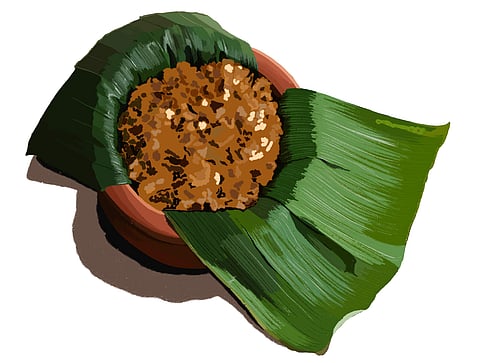

Cooking became a respite from boredom for many during the lockdown last year. What followed was them posting about their culinary 'achievements' on social media, especially Instagram. The lockdown also saw some food fads, including the infamous Dalgona coffee. But when The Big Fat Bao — as this graphic designer and illustrator is known on Instagram — saw this, she found it absolutely unrelatable. "I was not able to see the kind of food I ate while growing up and still continue to eat today. People were baking and cooking vegetarian and non-vegetarian food but it was food that upper caste people prefer," says the 30-year-old. So after completing her series for Dalit History Month, Bao embarked on a series called Caste and Food. "I really thought that I would see the kind of food we ate, but I couldn't find it on Instagram. Therefore, I decided to work on this series to talk about the nexus of caste and food and how it is related to gender and institutional oppression," she says.
Over the last eight weeks, Bao has posted 11 illustrations in the series. And what's unique about the posts is that she also gives recipes for each of the different dishes. "Food is always seen as an unifying factor. Mainstream media mostly shows food in abundance but that is not the reality for us Dalits. Our curries are watery as it has to feed many mouths and it is not made with expensive ingredients," says Bao. "Our access to ingredients is limited because of years of social and economic exclusion. So what kind of food do Dalits eat? It is definitely not as rich as upper caste food," she adds. It was this stark reality that Bao wanted to highlight in her series. It is also an attempt to find out why Dalits eat the food that they eat, she says.
Everything that Bao has illustrated for this series is food that she has eaten. But she believes it is not part of her culture. "I refuse to call it culture or cuisine. This is food that's born out of extreme oppression against marginalised communities. For anything to become a symbol of culture, it has to be accepted by the people," says Bao. So this series is far from a celebration of food, it is rather an attempt to show the consequences of institutional oppression. In one of her Instagram posts, Bao says, "As much as food is a site for knowledge, it is also a site of oppression, humiliation and claim for modernity. In many ways, it deems people lowly due to their food practices."
Some of the dishes that Bao has illustrated for this series include Rakti — a type of food that is made from boiling the blood of cows, buffaloes, goats, and sheep — and Lakuti, which is prepared from Rakti. Some other dishes include egg curry, Bhakri (a type of chapati) and Bhanore, which are fluffy rice cakes. "People from marginalised communities can relate to this food. I have received messages on Instagram from people telling me about what the food is known in their region and during which season they prepare it," Bao informs. To create the illustrations, Bao, who studied graphic designing from DJ Academy of Design in Coimbatore, used Adobe Photoshop and Procreate.
